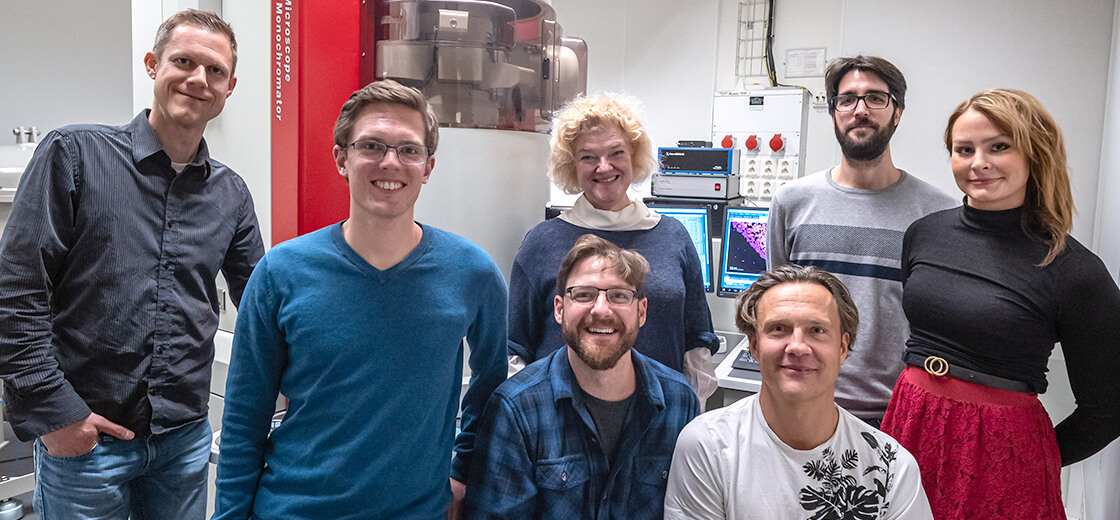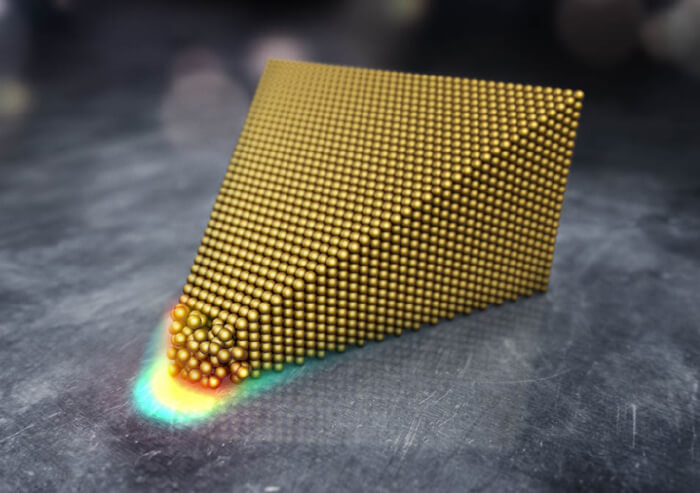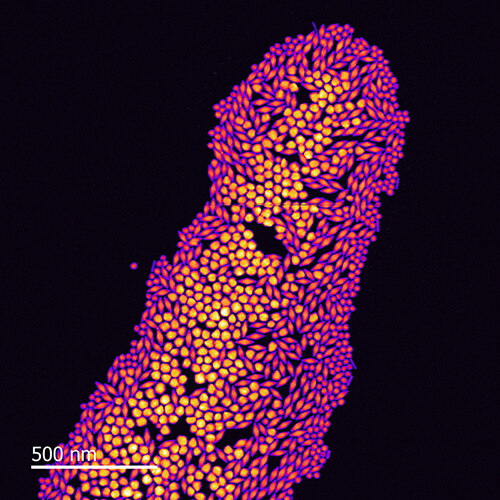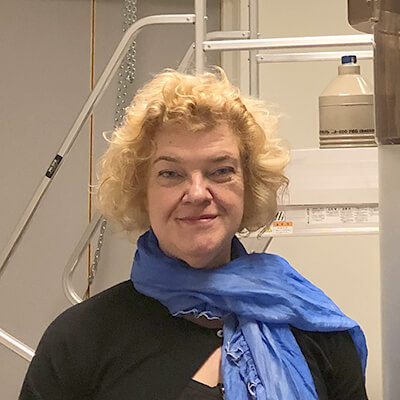Super High Precision Imaging, High Spatial and Energy Resolution Spectroscopy and In situ Electron Microscopy for Materials for Tomorrow and a Sustainable Future

INTERVIEW 09
Eva Olsson
Professor, Department of Physics, Chalmers University of Technology
Chair of Research Division, Member of the Swedish Royal Academy of Sciences, General Secretary of
International Federation of Societies for Microscopy (IFSM)
Introduction
The research division of Eva Olsson focuses on understanding the correlation between local structure and properties of hard and soft matter and also their correlation to fabrication parameters.
Interfaces are of particular interest due to their significant influence on the properties and microstructural evolution. The goal is a fundamental understanding of the properties of materials and knowledge of how to design the materials for tomorrow and devices with tailored properties.
The research ranges from basic to applied research and is carried out in collaboration with partners from academia, institutes and industry. The main research activity is imaging, diffraction and spectroscopy using advanced and state-of-the-art electron microscopy and in situ techniques.
Exploring the materials for tomorrow
Professor Olsson, with her research group, combine expertise in different materials and experimental techniques of imaging, diffraction and spectroscopy. Together they formulate the strategies to address crucial questions concerning the role of atoms in determining the function and dynamics of the most advanced material structures and how to design the materials and devices for tomorrow.
The actual research is like detective work, Professor Eva Olsson says. It is observing, searching for clues, understanding the context and building a knowledge base that makes it possible to develop ideas and concepts further. That is what is exciting and the driving force, she says.
- For me, time doesn’t matter. It is never like I close the door at five o'clock, and don’t think about science until the following day. If something needs to be done, then it needs to be done. For me there is such a fascination and joy in the actual research that I just spontaneously keep on working.
- What is most important and fascinating about the research is that it helps making our society more sustainable and environmentally friendly, Professor Eva Olsson says. We answer questions about how we can improve materials and make them intelligent with multitasking capabilities.
Professor Eva Olsson's ambition is to gather Ph.D. students and post docs from around the world with exceptional skills and complementary expertise. The aim is to promote them and incorporate them in networks, building an international platform for the research, which takes place both locally but also in collaboration with various research groups.
- I want to make sure that we don’t constantly follow one single thought, the same idea, the same approach. I always want to ensure that there is a development, that we create a dynamic environment. We do this through contact with the students, and with young researchers who come here and work with us, by organizing workshops and by inviting the world's leading researchers to come here, but also by visiting other groups all over the world. All this allows us to build a research environment that is stimulating and beneficial to us all.
What inspires you?
- Discussions, collaborations, sunshine and a good cup of coffee, Professor Eva Olsson says, smiling as she continues.
Discussions and interaction with people are very important to Professor Eva Olsson. An experience may be of even greater value in the discussion with others, she says.
- It is a privilege to examine a topic from many different points of views to find a way forward in discussions with friends and colleagues. To have the opportunity to address multifaceted phenomena with detailed knowledge in different fields and the fact that there is a respect for each other and an interest to exchange ideas and views, regardless of research team or whatever it may concern, it is incredibly important and rewarding, she says.
Microscopy is like entering another dimension and space.
- Studying sophisticated materials structures in a microscope and exploring the correlation between structure and properties, even surpassing the scale of individual atoms in precision– it’s like an eternity, a universe to marvel, Professor Eva Olsson says.
Catalysis — the importance of precision
Catalysts are materials which cause or accelerate chemical reactions. For most of us, our first thought is probably of catalytic converters in cars, but catalysts are used in a number of areas of society — it has been estimated that catalysts are used in the manufacture of more than 90 percent of all chemicals and fuels. No matter how they are used, catalysts operate through complex atomic processes.
Within the framework of the Competence Centre for Catalysis at Chalmers combining advanced high-resolution electron microscopy and new types of computer simulations, it was shown that picometre-level changes in atomic spacing in metallic nanoparticles affect catalytic activity. The nanoparticles consisted of platinum and using sophisticated electron microscopes the accuracy of determining the position of the atoms was improved and it was even possible to reach sub-picometre precision. Using the information from the microscope, it was possible to simulate exactly how the catalytic process is affected by small changes in atomic distances. The results have broad implications.
- Our methods are not limited to specific materials but instead based on general principles that can be applied to different catalytic systems. As we can design the materials better, we can get both more energy-efficient catalysts and a cleaner environment, says Professor Eva Olsson.
In situ studies of gold — new discoveries
In situ electron microscopy enables the direct observation of correlation between material structure and properties on small scales reaching the atomic level. Examples of important mechanisms that can be studied are those of transport properties of charges, heat, liquids and particles in complex structures and also of effects induced by light, mechanical strain and temperature changes.
The direct correlation on the small scale involving individual interfaces, defects and atoms, provides access to new information about which microstructural constituents are active in determining the material properties on the macro, micro, nano and atomic scale. New aspects of material properties as well as mechanisms not obvious from measurements on the macro scale can also be revealed due to the high spatial resolution. The knowledge is crucial not only for the understanding of the mechanisms that are involved but also for the design or materials and devices with tailored properties.
The need for high spatial resolution imaging and spectroscopy of both surfaces and internal structure can in many cases only be met by transmission electron microscopy (TEM) or a combination of electron microscopy and other techniques. The research division of Professor Eva Olsson TEM develops and uses holders for in situ dynamic experiments and manipulation including studies of transport of charges and condensed matter and also the effects of electric fields, temperature and light on properties and material structure.
One example of the in situ studies is the effect of extremely high electric fields on the surface structure of gold. A new effect was discovered by observing the surface at the highest level of magnification and increasing the electric field step-by-step to extremely high levels. Under the influence of the electric field, the gold atoms suddenly lost their ordered structure and released almost all their connections to each other. Upon further experimentation, the researchers discovered that it was also possible to switch between an ordered and disordered, i.e. molten, structure at room temperature.
The discovery of how gold atoms can lose their structure in this way is not just spectacular, but also scientifically groundbreaking. Theoretical calculations suggest that the formation of defects in the surface layers is due to the lowering of the energy required to introduce defects. Possibly, the surface melting can also be seen as a so-called low-dimensional phase transition. The ability to melt surface layers of gold in this manner enables various novel practical applications in the future.
"Because we can control and change the properties of the surface atom layers, it opens doors for different kinds of applications. For example, the technology could be used in different types of sensors, catalysts and transistors. There could also be opportunities for new concepts for contactless components," says Professor Eva Olsson.
Most exciting challenges ahead?
What is most exciting right now in Professor Eva Olsson’s research field is to explore the possibilities of soft microscopy, because it opens up new possibilities in materials research and materials physics. The high precision and in situ methods will be further developed. In addition, the high energy resolution electron energy loss spectroscopy using the monochromated JEM-ARM200F is offering new opportunities in the very low energy loss interval for studies of strong coupling with, for example, phonons and plasmons. In addition, the segmented STEM detector offers the possibility of dynamic in situ studies of the distribution of electric fields in materials at high spatial resolution. This is important e.g. for further development of future energy harvesting and storage as well as quantum technology. A strong and vivid interaction with collaboration partners at JEOL will be mutually most fruitful.
- It is clear from the many collaboration projects and interaction with colleagues in academia and industry that there is a growing interest in soft organic materials in parallel to further advancing inorganic materials. We have taken the challenge to establish new approaches to widen our abilities to develop intelligent hybrid materials structures, Professor Eva Olsson explains.
In a new project, strong light-matter coupling will be explored, where light and matter intermix to form new compositional light-matter quasi-particles called polaritons. Their hybrid character gives polaritons a set of intriguing optical and electronic properties.
- We look forward to combining unique cutting-edge abilities and building a platform for new knowledge about the interaction between light and matter. We can dive even deeper and push the boundaries of what is possible to study and understand in the dimensions of both time and space, says Professor Eva Olsson
Tailoring strong light-matter coupling at room temperature is an important challenge, since today’s quantum technology needs extremely low temperatures and advanced laboratories. Through developing a concept which can work at room temperature, researchers can create sought after opportunities. Doors open to new applications in society, such as ultrafast optical switches, quantum information and new energy-saving light sources. Light and matter exist everywhere around us and are essential to our lives. This new knowledge could also be used to customise material properties, for example, the reactivity of chemicals.

Figure caption 1. An illustration of a gold nanocone where the structure of the gold atoms at the tip switches from crystalline order to a disordered surface layer under the influence of an extremely high electric field. The field is illustrated in the rainbow colour scale where yellow indicates a higher field compared to turquoise (Image credit: Alexander Ericson).

Figure caption 2. An annular dark field scanning transmission electron microscopy image showing a collection of gold bipyramid nanoparticles grown in solution. The morphology and size of the nanoparticles can be controlled by using surfactants during the particle growth in solution. This allows the tailoring of nanoparticles for different applications and tuning of properties (Image credit: Andrew B. Yankovich).

Eva Olsson
Professor, Department of Physics, Chalmers University of Technology, Gothenburg, Sweden; Member of the Swedish Royal Academy of Sciences, Physics Class; General Secretary of International Federation of Societies for Microscopy (IFSM).
Graduated at Chalmers University of Technology, Department of Experimental Physics. Joined Physical Sciences at IBM T.J. Watson Research Center, Yorktown Heights, USA, as a post doctoral fellow in 1989-1991. Became Assistant Professor followed by Associate Professor at Chalmers University of Technology, Department of Experimental Physics. In 1997 she was appointed Full Professor at Uppsala University, The Ångström Laboratory, and in 2001 she was appointed Full Professor at Chalmers University of Technology, where she is head of a research division. In 2017 she was a Japan Society for Promotion fellow at The University of Tokyo.
Posted:January 2020
